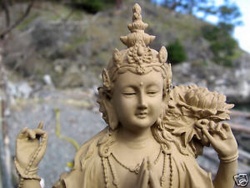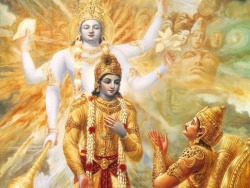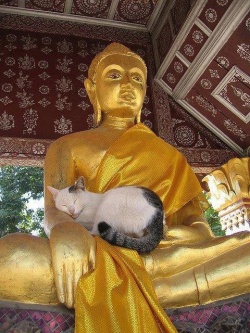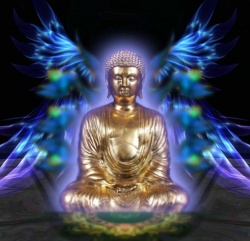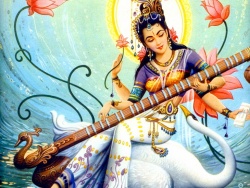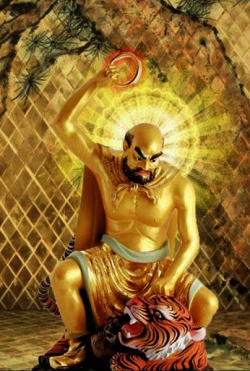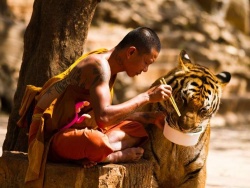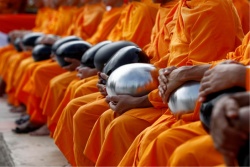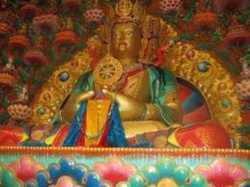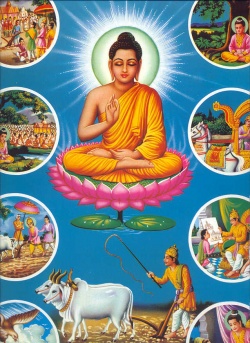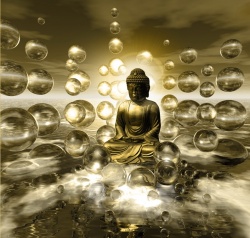Manual of Pramana - Reading Eight: Definitions and the Things They Define
Selection from the collected topics:
Definitions and the Things They Define
The following reading consists of the Presentation of Definitions and the Things They Define (mTsan-mtson gyi rnam-bzhag), from An Explanation of the Elementary Path of Reasoning (Rigs-lam chung-gi rnam-par bshad-pa), by the Master Tutor Purbuchok Jampa Tsultrim Gyatso (1825-1901), who in his day held the position of Tutor to the Dalai Lama.
_______________
Here secondly is our own position. There is a definition of something defined, because it is the following:
A case where all three of the nominal qualities are present.
There is a way of enumerating these three “nominal qualities,” because the following is a correct list of the three:
1) Generally speaking, the thing should be something to be defined;
2) It should apply to some definitive example for it; and
3) It should be something defined only for whatever its definition is, and not for any other.
There is a definition of a definition, because it is the following:
A case where all three of the material qualities are present.
There is a way of enumerating these three “material qualities,” because the following is a correct list of the three:
1) Generally speaking, the thing should be a definition;
2) It should apply to some definitive example for it; and
3) It should be a definition for nothing other than the thing it defines.
There does exist a definition of what “that which performs a function” defines, because it is the following:
That case where all three of the nominal qualities pertaining to “that which performs a function” are present.
There does exist a definition of the definition of a working thing, because it is the following:
That case where all three of the material qualities pertaining to “working thing” are present.
There does exist a definition for a definitive example where all three of the nominal qualities for “that which performs a function” are present, because it is the following:
That case of “that which performs a function” where all three of the nominal qualities for “that which performs a function” are present.
There is a definitive example of such a thing, because a working thing would be one.
There is an alternate definition for something to be defined, because it is the following:
A case where all three of the qualities for being establishing as something are present.
There is a way of enumerating these three qualities for being established as something, because the following is a correct list of the three:
1) The thing should be something to be defined;
2) It should not be something defined for any other definition than its definition; and
3) It should be possible with whatever we are considering a definitive example.
There is also such a definition for a definition, for it is the following:
A case where all three of the qualities for establishing something are present.
There is a way of enumerating these three qualities for establishing something, because the following is a correct list of the three:
1) The thing should be a definition;
2) It should not be a definition for any object to be defined other than the one it defines; and
3) It should be possible with whatever we are considering a definitive example.
There is also such a definition for a definitive example, because it is the following:
An example which typifies the object to be defined for the particular definition in question.
We can illustrate these with a specific case. There is a definition for the object defined by “that which performs a function,” because it is the following:
A case where all three of the qualities for establishing something through “that which performs a function” are present.
There is a way of enumerating these three qualities for being established as something by “that which performs a function,” because the following is a correct list of the three:
1) The thing should be something to be defined by “that which performs a function”;
2) It should not be something defined for any other definition than “that which performs a function”; and
3) It should be possible with whatever we are considering a definitive example of the thing to be defined by “that which performs a function.”
There is a definition for the definition of a working thing, for it is the following:
A case where all three of the qualities for establishing something as a working thing are present.
There is a way of enumerating these three qualities for establishing something as a working thing, because the following is a correct list of the three:
1) The thing should be a definition for “working thing”;
2) It should not be a definition for any object to be defined other than “working thing”; and
3) It should be possible with whatever we are considering a definitive example for the definition of a working thing.
There is also such a definition for a definitive example of a working thing, because it is the following:
An example which typifies the working thing defined by “that which performs a function.”
There does exist a definitive example, since a water pitcher would be one. Generally speaking, definitions may be divided into two types: (1) definitions which disallow dissimilar types; and (2) definitions which disallow wrong ideas.
An example of both of these would be something like:
A state of mind which is (1) a fresh, unerring perception, and (2) which is free of conceptualization and also unmistaken.
This is a definition which is both kinds: one which disallows dissimilar types, and one which disallows wrong ideas. And this is because it is (1) a definition which disallows dissimilar types, and (2) a definition which disallows wrong ideas.
The first element mentioned is correct, because those states of mind which are dissimilar to direct valid perception are limited to precisely two: perceptions which are not valid, and deductive valid perceptions; while perceptions which are not valid are disallowed by the part of the definition that says, “fresh, unerring perception,” and deductive perceptions are disallowed both by the reference in the definition to “free of conceptualization” and also by the reference to “unmistaken.”
The second element mentioned is correct, because—although the references to “free of conceptualization” and to “unmistaken” each by themselves disallow dissimilar types—they each address a different wrong idea, and so both “free of conceptualization” and “unmistaken” are mentioned, to disallow these wrong ideas. Something like the sense perception where one moon appears to be two is also a state of mind free of conceptualization, and so someone might wonder whether it’s a direct valid perception; and so the part about “unmistaken” is added to disallow this wrong idea. The (non-Buddhist) Logician School (the Nyayika) believe that direct perception is a kind of conceptualization; the part about “free of conceptualization” is added to disallow their wrong idea.
Reasons for the Absence of Something
Which Involve Something Perceptible
The following selection is taken from An Explanation of the Art of Reasoning (rTags-rigs), also by the great tutor, Purbuchok Jampa Tsultrim Gyatso.
_______________
There are two parts to our explanation of a correct reason for the absence of something which involves something perceptible [to the opponent]: the definition, and the divisions.
Here is the first. The definition of a correct reason for the absence of something which involves something perceptible is the following:
That thing which is both (1) a correct reason for the absence of something in a particular proof; and (2) such that the thing which is considered the main element of all which is denied by the proof is not an abstruse object to the person for whom his same reason fulfills its role in the relationship between the subject and the reason.
This type of reason may be divided into two types: a correct reason used to prove the absence of something perceptible in a particular proof, by virtue of the absence of a corollary which possesses a relationship [with whatever is denied]; and a correct reason used to prove the absence of something perceptible in a particular proof, by virtue of the presence of a corollary which is contradictory [to whatever is denied].
Here are the respective definitions of these two different types. The definition of the first is:
That thing which is both (1) a correct reason used to prove the absence of something perceptible in a particular proof and (2) a negative thing in the sense of being an absence of something.
The definition of the second is:
That thing which is both (1) a correct reason used to prove the absence of something perceptible in a particular proof and (2) either a negative thing in the sense of not being something, or a positive thing.
The first may be divided into four different types: those reasons for the absence of something where the reason involves a cause, a comprehensive set, a nature, or an immediate result.
Respective definitions of these four are as follows. The first is defined as “A reason for the absence of something perceptible where the three relationships hold, and where this reason represents a cause.” This same pattern holds for the other three.
Respective typical examples of the four are as follows. The first would be “there is no fire there,” used as a reason to prove that there is no smoke on the surface of a [totally dark] nighttime ocean.
An example of the second would be “there are no trees there,” used as a reason to prove that there are no juniper trees on the surface of a barren rock crag where no trees can be perceived by a valid perception.
An example of the third would be “no water pitchers can be perceived there by a valid perception,” used as a reason to prove that there are no water pitchers in a particular place where no water pitchers can be perceived with a valid perception.
An example of the fourth would be “there is no smoke, its immediate result, there”—used as a reason to prove that there the immediate cause of some smoke does not exist atop a particular wall which is totally devoid of any smoke.
Different Types of Ceremonial Debates
The setting for debate in Tibetan Buddhism ranges from he intimate to highly ceremonial debates before thousands of assembled monks. Walking around Sera Mey Monastery at any given time of the day or night, you can hear the sound of heated arguments and the slap of hands floating out of any window, or from atop any of the flat roofs of most of the buildings, as friends or classmates challenge each other in spontaneous debates that go wherever their fancy takes them. Khen Rinpoche Geshe Lobsang Tharchin has often said that the reason he attained the highest standing among the highest ranks of geshes in the year he graduated was because of the constant exchange between him and his roommate, the great geshe Jampel Sengge, who went on in later years to become the teacher of Guiseppe Tucci, one of the greatest Tibetologists of history.
Debate is often used in a private scripture class. Student monks in a Tibetan monastery may visit the classes of different teachers throughout their career, and choose the one who most fits their own needs. At any given time for the sophomore class, for example, there may be three or four great teachers instructing different groups of its members. Classes normally take place early in the day—the teacher reads through a few pages of scripture with the students, constantly throwing in pieces of debate about difficult questions. It is very common for the teacher to take the role of the attacker, and then all the students to yell back in unison, as a defender. Then by evening the students are prepared to debate the topic of the day, having reviewed it themselves in their own rooms during the afternoon.
As mentioned before, the first debate of the evening for any particular monk in the geshe program is a “one-on-one” with another young monk, chosen by wandering around the monastery debate park until you catch the eye of someone you think might be good. (It feels much like a high-school dance!)
If the other monk is from a lower class, you get to review what you learned before; if he’s from a higher class, you get to explore something you will be studying within a year or two.
Later on in the evening the monks bunch up into class groups, clustered around a single attacker and one to three defenders. The subject here will follow the readings of your class for the week, whether it be the perfection of wisdom (prajnya paramita), middle-way philosophy (madhyamika), vowed ethics (vinaya), logic (pramana), or higher knowledge (abhidharma).
Once a week, two entire classes challenge each other on a rotating basis, in a debate called damcha (dam-bca’), a word which literally means “a position taken.” One class selects two of their best members to defend; and they come first and seat themselves on a special platform at the head of the debate park. These two will be the only defenders for the whole night, although their classmates are allowed to shout out helpful answers, and jibes at the attackers from the other class.
The attack begins with one of the senior members of the other class, who rises and raises the first question. He continues to a certain point, often decided by the debate master, when the next member of the class by seniority rises to pose a different question. If the debate is particularly hot, other members of the class leap up to throw in their own points, and before long there is a wonderful scene of a whole row of students screaming great questions, often in perfect unison. (It looks a little like a chorus line!)
This again is a great opportunity for the older class to review their knowledge, while members of the younger class get to hear arguments inevitably referring to the more advanced subject which the older class is on at the time. Damcha debates can continue into the wee hours of the night, until the debate master pulls the debaters off each other. Most of the monks wander home, while a group of diehards might go on in a cluster in some corner of the debate park, sometimes until dawn.
Two or three times a year, all monks in the geshe program are required to attend a gyuktru (rgyugs-sprod) or “examination” debate. This is to test their progress in their studies before a board made up of the abbot, the debate master, and a number of senior geshes. Each monk will have an opportunity both to defend on one question, and to attack on another. These debates are very brief and heated, since each side knows they only have a few minutes to demonstrate their ability before the debate master calls a truce and the next pair begins (there are hundreds of students to get through in only a few days).
The question of who will qualify for the geshe and other degree examinations is primarily based on the scores from these regular exams.
The degree examinations are the most critical and ritualized debates, and all of them are also called damcha. The first major degree exam in a monk’s career is the rikchung examination; appearing for such an examination is known as rikchung tsoklang. The meaning of the word rikchung (rigs-chung) is somewhat uncertain, but Khen Rinpoche states that it probably refers to the level of a student’s ability in the science of reasoning (rigs-pa), which at this point (after twelve or thirteen years of debating) is considered “lesser” (chung). The expression tsoklang (tsogs-lang) most likely refers to the fact that the student must stand up (lang) in the entire assembly of monks (tsok) fromhis own monastery to defend his understanding. It also may ultimately be a corruption of the expression tsulen (tsod-len), meaning to “judge the ability or capacity” of the candidate’s knowledge of the art of reasoning (rigs-pa’i tsod len).
A rikchung debate is rigorous, requiring many months of training by one’s teacher. Each candidate must prepare, with his teacher’s help, a formalized debate on a topic assigned by seniority—the “best” topics, such as compassion, being awarded in advance to the best debaters. The opponent will be another member of the class, and there are also large chunks of scripture to be memorized for the required chanting section.
Practically the entire debate, down to whoa’s and tsa’s, must be memorized in advance. Flowcharts are prepared showing all the possible appropriate responses to every possible answer. The flowchart splits, and half becomes totally useless, when the opponent during the actual debate answers, for example, “wrong!” (tak ma drup) or “not necessarily!” (kyappa ma jung). After the rough flowchart has been prepared by the candidate and his teacher, it is handed over to a calligrapher, who prepares a huge banner with all possible exchanges (even though the actual debate will ultimately only go down one branch).
This banner is pasted to door of the candidate’s room, where he can review it frequently. He will also spend many months out in the cornfields, practicing by himself, out of earshot of the opponent or his buddies (who are always trying to find out in advance what issues he plans to raise).
Here he will also practice, over and over, every move of the entire debate: how to bow to the abbot at the beginning; when to put on or remove the high, peaked ritual hat; when to stand, when to sit; when to wave what arm; how to wear the (incredibly heavy and hot) ritual robes and other accoutrements.
The rikchung debate is a very serious moment in a student monk’s life; if he fails to be among the small number of qualifying candidates (perhaps only 12 of the entire class), he will not be eligible for the geshe examinations much later. After a successful rikchung debate there is usually a big party: mom and dad, sister and brother, are usually down fromother refugee camps in India to see the big event; and the opponent, your teacher, and all your classmates show up with gifts and silk scarves to help you celebrate.
The rikchen (chen meaning “greater” ability to reason) debate is the next big step, and immediately precedes the geshe exams for higher ranks of geshes. It is basically the same as the rikchung exam, except that it takes place in the tsokchen (the great hall shared by the two monasteries involved, such as Sera Mey and Sera Jey Monasteries), and the opponent comes from the sister monastery. The audience now is not only all the monks of your monastery (over a thousand now at Sera Mey, for example), but also all the monks of the opponent’s (Sera Jey, for example).
Both the rikchung and rikchen debates also call for a night of defending your ability at your own college, or kangtsen (khang-tsan). Sera Mey, for example, is divided into some twelve surviving colleges; and the one which ACI students are affiliated with is that of our root lama, Khen Rinpoche Geshe Lobsang Tharchin. This is Gyalrong College, home also to the illustrious Pabongka Rinpoche. The kangtsen defense is mostly a dry-run among friends, to get the student ready for the pressure of the other, larger debates to come.
The debates for a geshe candidate are, of course, the most rigorous. There are many levels of geshe, and different kinds of geshes even among different monasteries of the same tradition. A candidate for the lingse (gling-bsres) or lower rank of geshe need only defend himself in the midst (se) of the assembled monks of his own monastery (ling). Debates for this rank of geshe are held about twice per year, and the number of candidates in each case is typically restricted to two.
The lingse candidate first defends himself in open debate against each member of his college, one-on-one, before the assembled college. The next step is a defense before each member of every one of the classes in the geshe program, which means every monk attending the debate park, each evening for about a week. Finally comes a grand defense before the assembled monks of the entire monastery, including all geshes and other monks who have graduated from the debate park already. The other details of the lingse debate are similar to the rikchung and rikchen debates, with a large amount of scripture to be memorized and recited also.
The debates for the hlarampa or highest rank of geshe are much more difficult, in the old days requiring an open defense before the assembled monks of every one of the six major Gelukpa monasteries. The opponent here is another highly qualified candidate selected by one of these other monasteries; normally, only one or two candidates are “fielded” by each monastery per year.
The final debates between hlarampa (hla rams-pa) geshes occur during the great prayer festival at the Tibetan new year; this was held in Lhasa (Hla-sa), and the candidates had to have mastered a veritable myriad (rab-’byams, shortened to rams) of scriptures. (This etymology comes from the Great Dictionary of the Tibetan Language.) The most successful of the hlarampa debaters were awarded “honors” (called anggi or “number’) by His Holiness the Dalai Lama at the Potala Palace—and our root lama, Khen Rinpoche, was awarded highest honors in the year he completed his geshe.
In recent years, an extended series of intensive debate examinations before a special board of abbots and their assistants, as well as written examinations, have been added to the process, lengthening the entire wait of a candidate who has already completed his class work, in some cases, up to eight or more years. A final special form of debate is the Winter Debates, called Jang Gunchu, a sort of annual Olympics between the great Gelukpa monasteries. Jang (‘Jang) is the name of a small monastery where these debates were held in Tibet, and gunchu (dgun-chos) means “Dharma event held in the winter.” In India, the debates are sometimes mistakenly referred to as the Jamyang Gunchu (“Winter Debates of Manjushri”).
Traditionally, a small group of hand-picked students in the geshe program—perhaps 50 from a monastery of thousands—was sent to Jang Monastery to participate. The monks would prepare a backpack and sleeping roll, and walk to the town of Jang, a good distance to the southwest of Lhasa. The sponsoring monastery of the debate was Rato, known for its tradition of masters of debate and logic. Here the monks would debate the very subjects of this course series—logic and Buddhist perceptual theory—from the great Commentary on Valid Perception of Master Dharmakirti. Special attention was given to its most famous Tibetan commentary, an extraordinary masterpiece by Gyaltsab Je, one of the principal disciples of Je Tsongkapa.
The Winter Debates would continue for an entire month, with nearly non-stop debating on a personal, class, and inter-monastery level for the entire day and—during special debates called tsenpe damcha—the entire night as well. (According to Khen Rinpoche, the word tsenpe is a corruption of the word tsenbu (mtsan-bud), meaning “all night long.”)
The invasion of Tibet marked the end of the Winter Debates. After a long hiatus, they were re-instituted in India, with the help of Khen Rinpoche and his students. They are now back to their original glory, attended by hundreds of the best young debaters and rotating each year between the “Big Three” monasteries of Sera, Drepung, and Ganden. They provide an excellent opportunity for the cream of the monasteries to get to know one another and “cross-fertilize” their thinking, making the entire tradition stronger.
Supplement to Reading Eight
Rikpay Drotang
Debating Format, Part One
Bumpa tokpa yinpay chir.
…Because a water pitcher is an unchanging thing.
Tak madrup!
Wrong!
Bumpa takpa mayinpar tel.
Are you telling me a water pitcher is not an unchanging thing?
Du!
Right!
Mayinte!
And why not?
Bumpa mitakpa yinpay chir.
Because a water pitcher is a changing thing.
Bumpa mitakpa yinpar tel.
Are you telling me a water pitcher is a changing thing?
Du!
Right!
See also
- Manual of Pramana - Reading One: Why Study the Art of Reasoning?
- Manual of Pramana - Reading Two: An Outline of All Existing Things
- Manual of Pramana - Reading Three: Quality and Characteristic
- Manual of Pramana - Reading Four: Causes and Results
- Manual of Pramana - Reading Six: Negative and Positive
- Manual of Pramana - Reading Seven: Contradiction and Relationship
- Manual of Pramana - Reading Eight: Definitions and the Things They Define
- Manual of Pramana - Reading Nine: The Concept of Exclusion in Perception
- Manual of Pramana - Reading Ten: The Concept of Time
- Manual of Pramana - CLASS NOTES part 1
- Manual of Pramana - CLASS NOTES part 2

